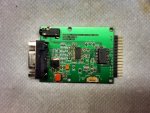@Pongo, those boards are used for 3d printers. There are many variations of the same thing but the pinouts are always the same. they have pins for power, gnd, step, dir, and the other pins are for jumper settings for 1/2, 1/4, 1/8, 1/16th stepping. I have these in my printer. all of them are good as long as you don`t overwork them. I have been using them 12 hours a day for months without an issue. Believe it or not you can get even cheaper ones from china ! for nema 17 they are good. I used to use Geckodrives, but at over $100 each, I now use the ones you described for nema 17`s.
OT for a moment, they now have a great little PCB maker as a complete project that looks really good. it uses the 3d printer setup but modified to be a pcb mill. If anyone wants to check it out, look up "cyclone PCB". It`s open source, and if anyone in oz wants to make one, I can make up the parts. I would make one myself, but too many other projects to finish first.
Marz.

